Abstract
The importance of intact host defense mechanisms for successful antimicrobial therapy was investigated via a comparison of the activities of ampicillin against experimental Listeria monocytogenes infections in normal mice and congenitally athymic (nude) mice. Nude mice were used for these experiments because recovery from infection with this organism depends on development of cellular immunity induced specifically by a T-cell-mediated reaction. When infections ampicillin per mouse (32 doses of 25 mg each), which is twenty times the dose required for a cure of infections in normal mice (8 doses of 5 mg each), would not cure infections in nude mice. With a reduction in inoculum to 10(5) colony-forming units, cures were obtained with a total ampicillin dose of 800 mg (32 doses of 25 mg each), but not with 400 mg (16 doses of 25 mg each). These studies show clearly that the efficacy of ampicillin against infections with L. monocytogenes is dependent upon intact host defense mechanisms.
Full text
PDF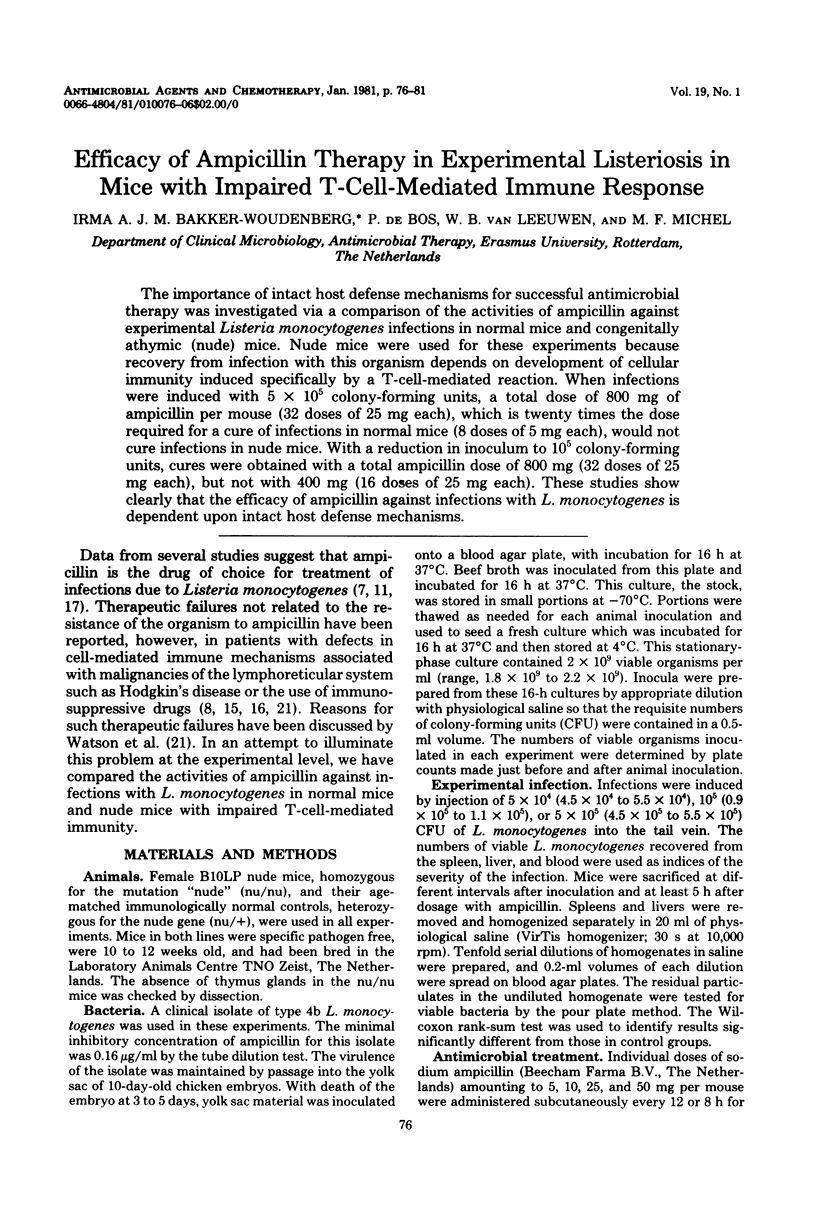
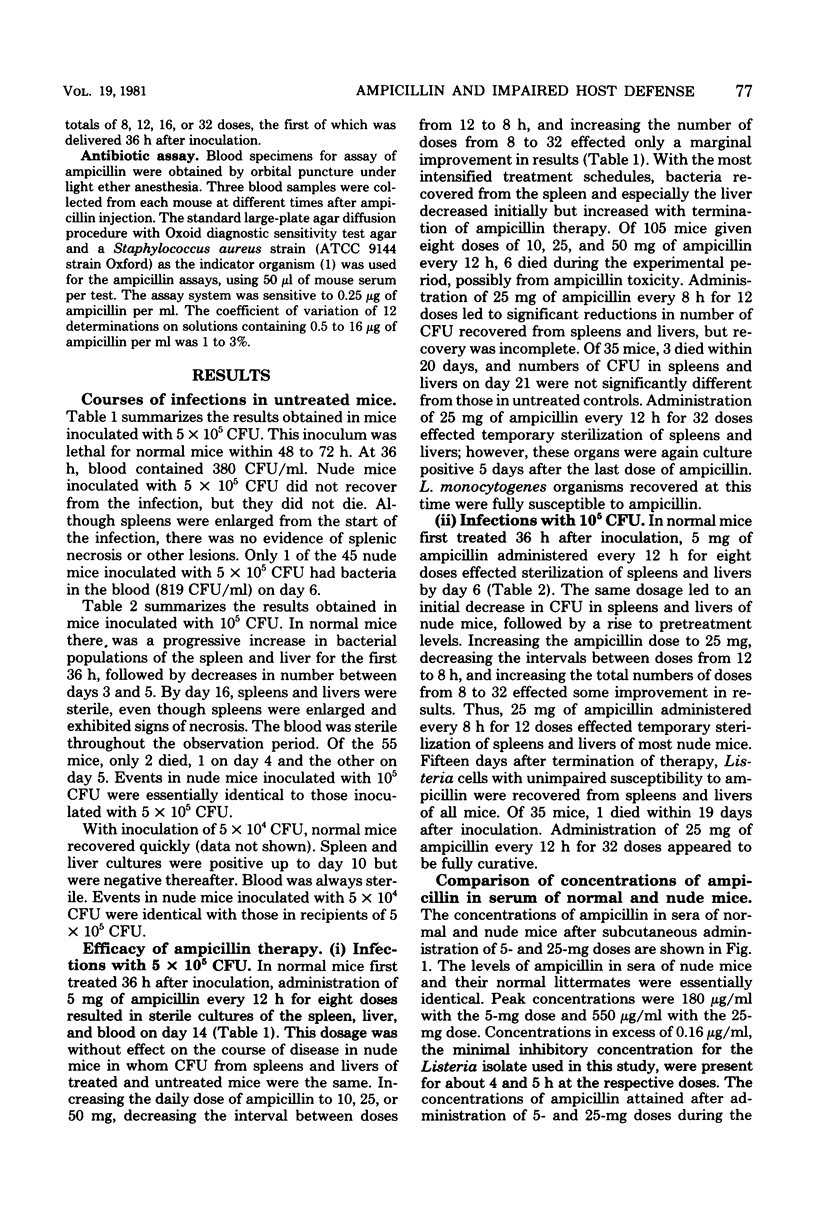
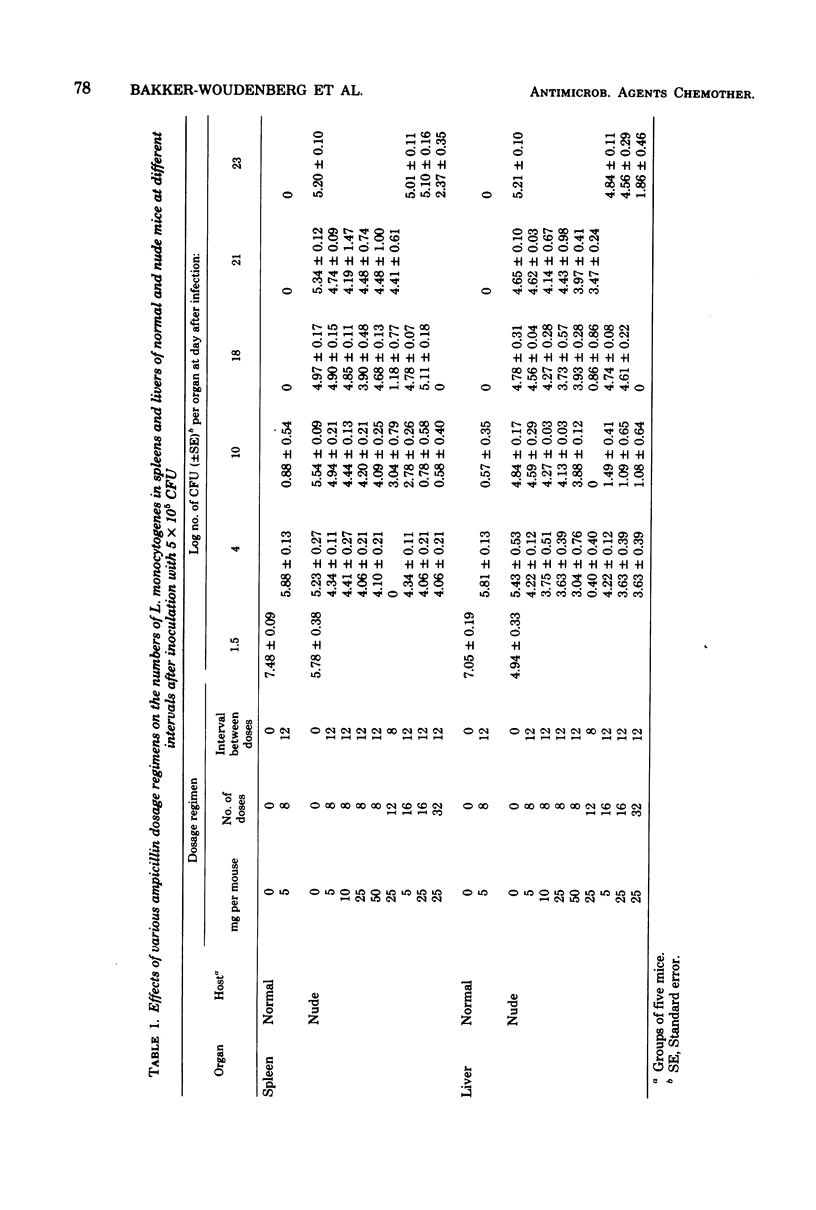
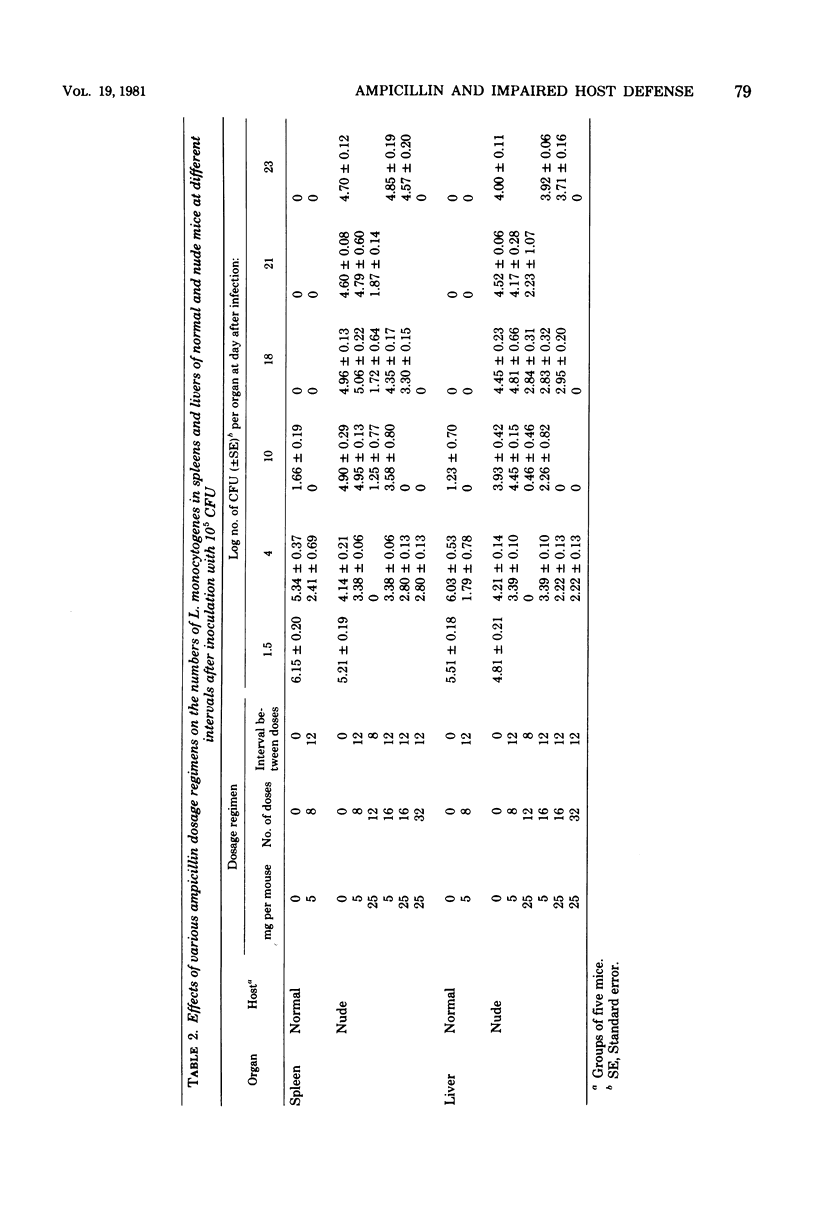
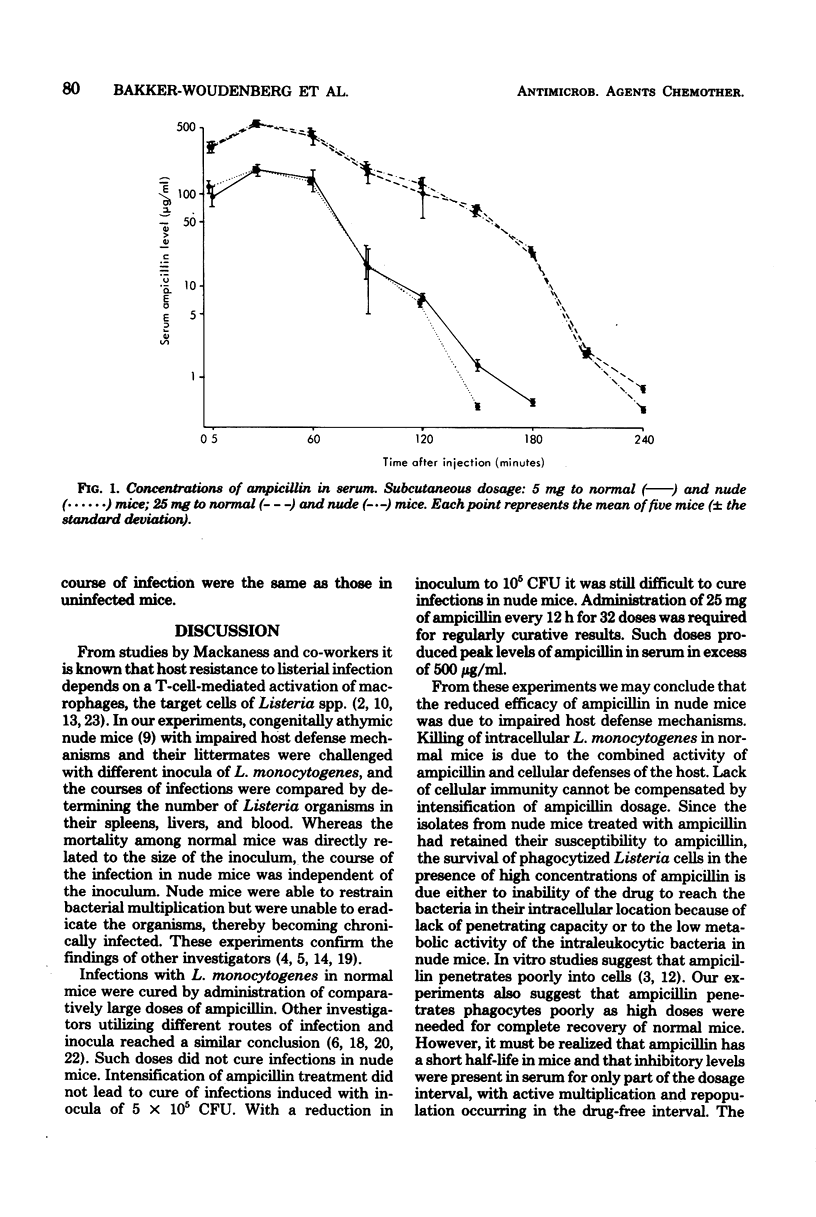
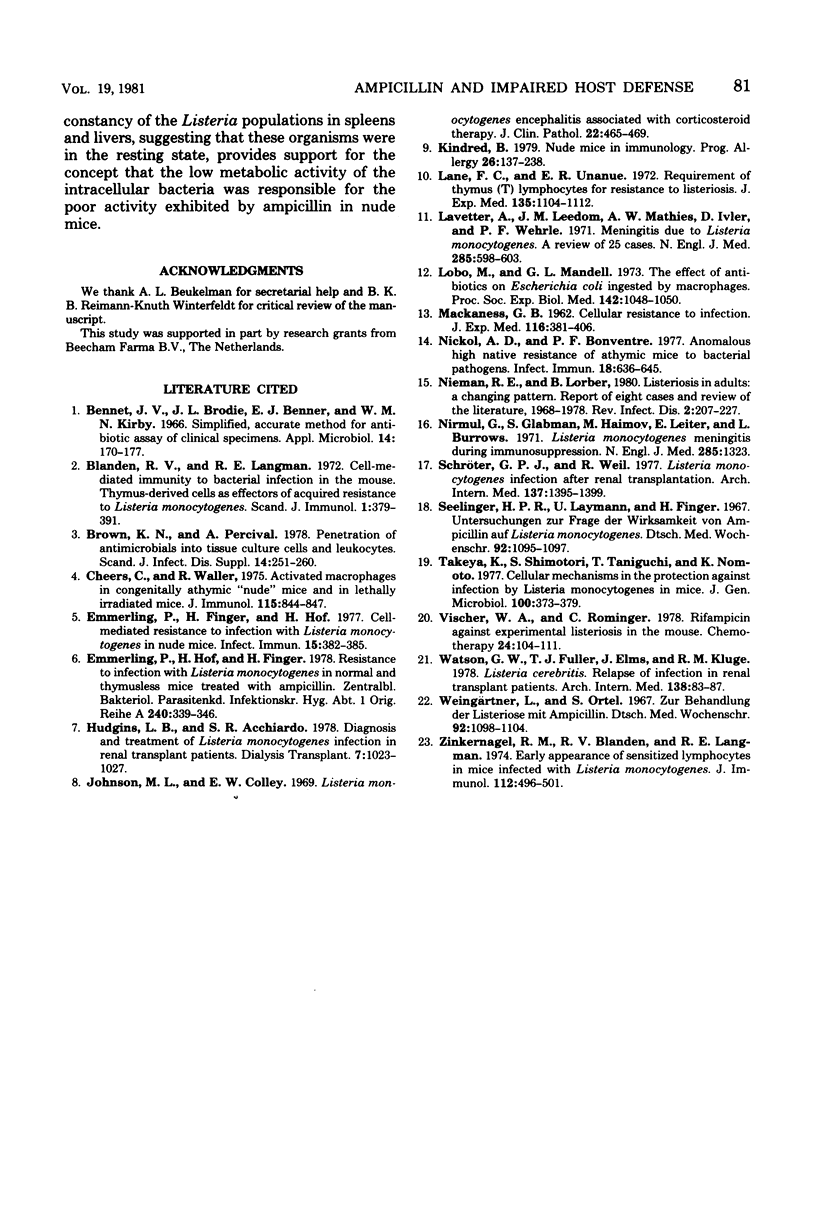
Selected References
These references are in PubMed. This may not be the complete list of references from this article.
- Bennett J. V., Brodie J. L., Benner E. J., Kirby W. M. Simplified, accurate method for antibiotic assay of clinical specimens. Appl Microbiol. 1966 Mar;14(2):170–177. doi: 10.1128/am.14.2.170-177.1966. [DOI] [PMC free article] [PubMed] [Google Scholar]
- Blanden R. V., Langman R. E. Cell-mediated immunity to bacterial infection in the mouse. Thymus-derived cells as effectors of acquired resistance to Listeria monocytogenes. Scand J Immunol. 1972;1(4):379–391. doi: 10.1111/j.1365-3083.1972.tb03304.x. [DOI] [PubMed] [Google Scholar]
- Brown K. N., Percival A. Penetration of antimicrobials into tissue culture cells and leucocytes. Scand J Infect Dis Suppl. 1978;(14):251–260. [PubMed] [Google Scholar]
- Cheers C., Waller R. Activated macrophages in congenitally athymic "nude mice" and in lethally irradiate mice. J Immunol. 1975 Sep;115(3):844–847. [PubMed] [Google Scholar]
- Emmerling P., Finger H., Hof H. Cell-mediated resistance to infection with Listeria monocytogenes in nude mice. Infect Immun. 1977 Feb;15(2):382–385. doi: 10.1128/iai.15.2.382-385.1977. [DOI] [PMC free article] [PubMed] [Google Scholar]
- Emmerling P., Hof H., Finger H. Infektabwehr von Listeria monocytogenes bei normalen und immundefekten Mäusen unter Ampicillintherapie. Zentralbl Bakteriol Orig A. 1978 Apr;240(3):339–346. [PubMed] [Google Scholar]
- Johnson M. L., Colley E. W. Listeria monocytogenes encephalitis associated with corticosteroid therapy. J Clin Pathol. 1969 Jul;22(4):465–469. doi: 10.1136/jcp.22.4.465. [DOI] [PMC free article] [PubMed] [Google Scholar]
- Kindred B. Nude mice in immunology. Prog Allergy. 1979;26:137–238. [PubMed] [Google Scholar]
- Lane F. C., Unanue E. R. Requirement of thymus (T) lymphocytes for resistance to listeriosis. J Exp Med. 1972 May 1;135(5):1104–1112. doi: 10.1084/jem.135.5.1104. [DOI] [PMC free article] [PubMed] [Google Scholar]
- Lavetter A., Leedom J. M., Mathies A. W., Jr, Ivler D., Wehrle P. F. Meningitis due to Listeria monocytogenes. A review of 25 cases. N Engl J Med. 1971 Sep 9;285(11):598–603. doi: 10.1056/NEJM197109092851103. [DOI] [PubMed] [Google Scholar]
- Lobo M. C., Mandell G. L. The effect of antibiotics on Escherichia coli ingested by macrophages. Proc Soc Exp Biol Med. 1973 Mar;142(3):1048–1050. doi: 10.3181/00379727-142-37173. [DOI] [PubMed] [Google Scholar]
- MACKANESS G. B. Cellular resistance to infection. J Exp Med. 1962 Sep 1;116:381–406. doi: 10.1084/jem.116.3.381. [DOI] [PMC free article] [PubMed] [Google Scholar]
- Nickol A. D., Bonventre P. F. Anomalous high native resistance to athymic mice to bacterial pathogens. Infect Immun. 1977 Dec;18(3):636–645. doi: 10.1128/iai.18.3.636-645.1977. [DOI] [PMC free article] [PubMed] [Google Scholar]
- Nieman R. E., Lorber B. Listeriosis in adults: a changing pattern. Report of eight cases and review of the literature, 1968-1978. Rev Infect Dis. 1980 Mar-Apr;2(2):207–227. doi: 10.1093/clinids/2.2.207. [DOI] [PubMed] [Google Scholar]
- Nirmul G., Glabman S., Haimov M., Leiter E., Burrows L. Listeria monocytogenes meningitis during immunosuppression. N Engl J Med. 1971 Dec 2;285(23):1323–1323. doi: 10.1056/NEJM197112022852318. [DOI] [PubMed] [Google Scholar]
- Schröter G. P., Weil R., 3rd Listeria monocytogenes infection after renal transplantation. Arch Intern Med. 1977 Oct;137(10):1395–1399. doi: 10.1001/archinte.1977.03630220037011. [DOI] [PubMed] [Google Scholar]
- Seeliger H. P., Laymann U., Finger H. Untersuchungen zur Frage der Wirksamkeit von Ampicillin auf Listeria monocytogenes. Dtsch Med Wochenschr. 1967 Jun 16;92(24):1095–1097. doi: 10.1055/s-0028-1103746. [DOI] [PubMed] [Google Scholar]
- Takeya K., Shimotori S., Taniguchi T., Nomoto K. Cellular mechanisms in the protection against infection by Listeria monocytogenes in mice. J Gen Microbiol. 1977 Jun;100(2):373–379. doi: 10.1099/00221287-100-2-373. [DOI] [PubMed] [Google Scholar]
- Vischer W. A., Rominger C. Rifampicin against experimental listeriosis in the mouse. Chemotherapy. 1978;24(2):104–111. doi: 10.1159/000237768. [DOI] [PubMed] [Google Scholar]
- Watson G. W., Fuller T. J., Elms J., Kluge R. M. Listeria cerebritis: relapse of infection in renal transplant patients. Arch Intern Med. 1978 Jan;138(1):83–87. doi: 10.1001/archinte.138.1.83. [DOI] [PubMed] [Google Scholar]
- Weingärtner L., Ortel S. Zur Behandlung der Listeriose mit Ampicillin. Dtsch Med Wochenschr. 1967 Jun 16;92(24):1098–1104. doi: 10.1055/s-0028-1103747. [DOI] [PubMed] [Google Scholar]
- Zinkernagel R. M., Blanden R. V., Langman R. E. Early appearance of sensitized lymphocytes in mice infected with Listeria monocytogenes. J Immunol. 1974 Feb;112(2):496–501. [PubMed] [Google Scholar]


